► CAR’s grand tourer group test
► New BMW 8-series faces off…
► …against stiff competition
The BMW 850i is ‘good, but not that good’. So declared CAR in 1990 after driving the sporting flagship that cost £60,000 when we cost £2. That initial verdict hit the nail on the head, and BMW didn’t replace the high-tech, high-lux 8-series when it went off-sale nine years and 30,000 sales later. It’s taken two decades for those original E31 models to gain currency as classics, but they’re definitely on the up. So perhaps it’s perfect timing for BMW to get its halo coupe back in the game.
Only, BMW hasn’t really been absent from this market for two decades, because the 8-series picks up where the last-generation 6-series left off. The cynic might dismiss it as an attempt to squeeze more money out of the same concept – the old 650i M Sport topped out at £74,250 in 2018, where our M850i test car weighs in at £99,525 before extras. Yes, power – still from a 4.4-litre V8 twin-turbo engine – balloons substantially, there’s now standard all-wheel drive, you get a load more equipment. But they’ve basically slapped a 2-series on to a 6-series bill.
Our three rivals will stress-test the BMW’s luxury, technology and dynamism as it moves up in the GT market: comparison with the Bentley Continental GT and Aston Martin DB11 AMR will reveal if the BMW can do the sporting luxury GT thing and actually look like good value versus the £200k (as tested) Brits. Meanwhile, the Lexus LC500 – another 2+2 coupe with a V8 from a premium mainstream maker – is here to keep the BMW honest. It’s cheaper at £86k and might do the job equally well.
The 8-series
Helping to distance new 8-series from old 6, the 8 is based on the modular CLAR architecture we’ve seen rolled out since 2015 on – in order of appearance – the 7-, 5- and 3-series. Crucially, the 8-series is built alongside the 7er at Dingolfing, and shares the 7’s ‘carbon-core’ construction. Our car is also specified with its double-bubble roof in optional carbon-fibre, helping lower the centre of gravity.
Not that the 8-series looks like it’s about to topple over: its rear screen lays almost horizontal – adults in the +2 rear seats assume the brace position – and the cartoonishly long BMW squats low and wide on gorgeous 20-inch alloys, like a sumo wrestler limbering up. It is, in fact, 43mm shorter and 28mm lower than a 6. The 8-series doesn’t try to shrink around you, rather it makes a virtue of its size. At speed, you notice the muted refinement of its large interior, the plushness of its well-controlled ride, and an ease-of-access to its 523bhp and 553lb ft that makes other traffic appear too slow, not you too fast. You feel calmed, indulged, the biggest fish.
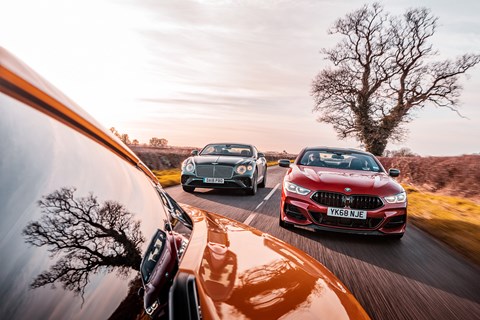
Its infotainment might be no different to a toppy 3-series, but this is a class-leading, versatile system that’s as intuitive as it is advanced. So long as there’s no one else in the car to mock you, you can even call out ‘Hey BMW’ as you might to Alexa, then tell it to switch radio stations, prime the sat-nav, all sorts, and it works. Familiar screens and interfaces are housed in a new4 leather-draped centre console, muscular like Superman’s torso, and our car features optional trinketry, including the iDrive controller and gearknob finished in cut glass like faceted diamonds.
You’d happily waft away imaginary continents. Except wafting does not top this 8-series’ to-do list, dynamics does, hence the high-profile M8 GTE motorsport programme. A tell-tale is a low-speed ride on steel springs and tank-track-thin tyres that’s far from poor, but never truly settles. There’s something supernatural to the M850i attacking a dark, wet country road. Laser lights turn night-time to day, and it bounds up on other cars like a headless horseman, twin-turbo V8 thumping hard all the way from 2000rpm with a deep bellow as the eight-speed auto scythes through ratios. All-wheel drive and supple high-speed damping allows you to simply squash the throttle, confident every drop of performance can be deployed, before – swish! – that car’s vanquished, whimpering by the hedgerow, wondering what witchcraft just turned it into a slug.
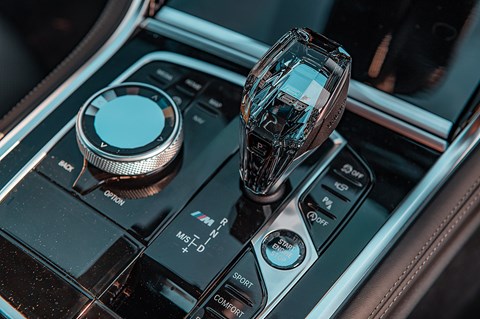
That enthusiasm translates to really twisty roads too, thanks to a combination of Integral Active Steering, rear-wheel steering, all-wheel drive and 20-inch Bridgestone Potenzas with outer shoulders like rolls of pastry. Select Sport and you get a weightier, more precisely detailed feel from the steering than Comfort, a sharper powertrain, and rear wheels that steer in the opposite direction to the fronts at up to 55mph – normally they steer in the opposite direction until 45mph, then in the same direction.
This all provides the M850i driver with great confidence to carve aggressively through a corner, exploiting grip all the while rather than hesitantly nursing. You are aware of an artificial effect being layered on by trick steering technology to make a larger car feel smaller and more nimble, though. Mostly this isn’t a problem, but on damp winter roads at 5ºC, the 850i will slide quite luridly if the mood takes you. At this point, the steering – both via the front and rear wheels – can feel too reactive. I prefer more languid responses in those moments.
The Continental GT
The Bentley is closest in spirit to the BMW of our foursome, but goes about its business rather differently. Launched last year, this is officially the third-generation Continental, but really the first since 2003 to be reinvented wholesale, not thoroughly revised. All-wheel drive upgrades from a set 60:40 split to a more dynamic affair, and there’s a new 48-volt active anti-roll system, as introduced on the Bentayga SUV. The W12 twin-turbo engine lives on, now with 626bhp and 664lb ft, which should be enough.
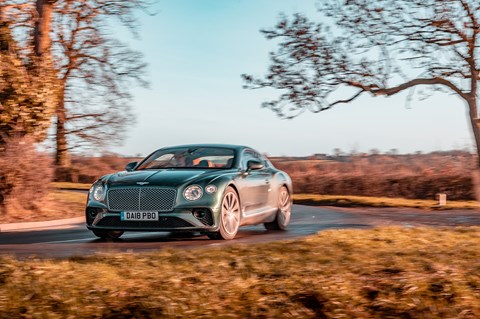
The interior significantly raises its game, and expertly manages potential conflict between the dusty craftsmanship a traditional customer might expect and the digital showmanship the Insta-generation craves. The seats are set low for a sporting feel, but even as you brush against them you feel the deep cushioning in their bolsters. The leather feels as rich as it smells, and everything you touch has heft and intricate detail – from the knurled effect behind the metal door pulls, paddleshifts and even the release pulls that tilt the front seats forward, to the Fabergé-like diamonds of the indicator stalks.
The instrument binnacle appears to clearly present its information in analogue dials, but is actually a twist on Audi’s digital cockpit that can magic a sat-nav map between speed and revs. But the Conti’s party piece is the three-faced infotainment4 screen that revolves like Toblerone meets James Bond’s number plate – a blank side, another housing three analogue dials, and a third containing the infotainment screen. It operates with a grace and precision so seamless you forget engineers slaved endlessly over it. This GT is also a relatively practical proposition, and while the Conti offers less boot space than the BMW – 358 litres plays 420 – you can actually get four six-foot-tall adults in the cabin with only moderate folding.
At low speed the Bentley soothes with its double glazing, distant hum of W12 and lulling air suspension. Control weights underplay this car’s Range Rover Sport heft, from electric power steering that twirls lightly but precisely, to brakes that you ease onto and never grab. Even the new dual-clutch gearbox has fine manners, gliding through ratios where others shunt.
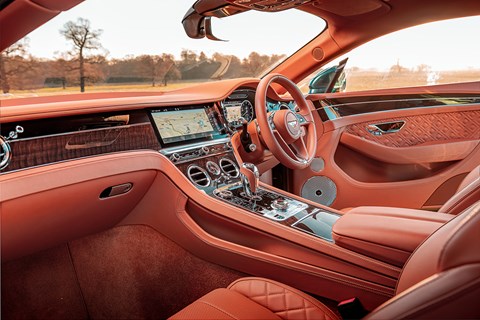
Naturally, the Bentley can make very high speed appear equally effortless. Plant the throttle and all four 21-inch P Zero tyres dig in and the Bentley surges forward with the stoic mission-focus of a torpedo. Acceleration is accompanied by purposefully deep woofles, mild flatulence and a low if distinct whistling, and it seems this engine could power the Flying Scotsman without breaking sweat. But goose pimples? Not really.
The Bentley is highly competent over a challenging road – its ride remains unflustered, brake discs like Fiesta wheels haul it up promptly given the weight swilling about, and its anti-roll system quickly processes speed and steering to present you with a highly natural – if strikingly composed – algorithm for perfect body control. You’ll maintain a very fast average speed without ruffling passengers, but the Bentley cannot match the BMW’s agility when you work the chassis really hard cross-country.
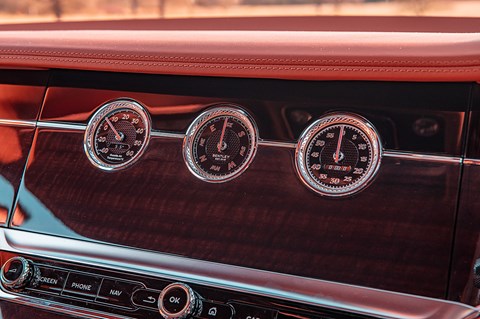
Approaching tighter corners at speed, the overriding impression is of managing a fast, heavy car with 12 cylinders arranged like the head of a gavel. You somehow make it through the apex, but the feel is cumbersome and reluctant after the enthusiasm of the BMW, and you sense that really this is a victory of torque vectoring, active anti-roll control and all-wheel-drive trickery in making a big car do something it doesn’t really want to. The Bentley is more about comfort, luxury and covering ground rapidly and safely in all conditions with a stiff upper lip, not yeehawing about the place in an unseemly manner.
The DB11 AMR
The Aston DB11 AMR can yeehaw. This, remember, is the halo model that plays on Aston Martin Racing exploits (hence the initials) for marketing purposes, and replaces the short-lived DB11 V12. Changes include dampers uprated 10 per cent front and rear (spring rates are unchanged), a stiffer rear subframe, uprated engine mounts and forged alloys, saving 3.5kg each.
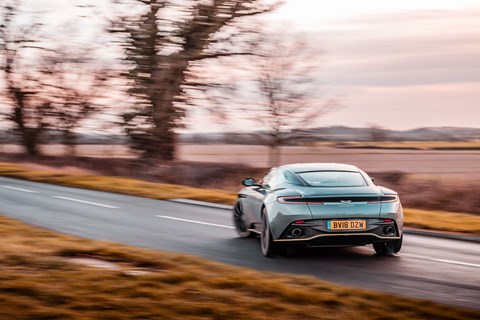
Aston has also taken the opportunity to tease Bentley – a 30bhp hike to 630bhp and 208mph top speed both slightly edge the car from Crewe. But the AMR’s also £16k pricier at £175k (though both are around £200k as tested) and its ample 516lb ft wilts next to the Bentley’s bellowing 664lb ft.
You’re ensconced by the Aston: low seat, high body sides and a fast screen angle matched by the extravagant rake of a high-set centre console. There are fine leather hides and smart carbonfibre, but the DB11 falls far short of the surprise-and-delight of the Bentley. Nor can the Aston match the Conti’s deep-rooted quality – air vents feel flimsy, paddleshifters click cheaply, and the Mercedes-sourced infotainment works effectively, but looks dated both in graphics and its screen housing. Owners might be okay with the Bentley’s infotainment being better, but it’s harder to stomach a BMW’s being so obviously superior.
Instead, the Aston pulls on your heart strings thanks to its design – surely the most achingly gorgeous GT of them all – and a drive with more drama than Netflix. Press the pulsating red starter and the V12 fires like a prodded lion deprived of sleep. Downsizing is a relative term with 5204cc and 12 cylinders still at large, but this engine captures much of the attitude of its naturally aspirated forbear, while adding all the benefits of turbocharging – there’s a swelling, volcanic energy from little4 over 2000rpm where the old DB9 felt lazy, a much stronger mid-range, and a pretty ferocious second wind from 5500rpm up.
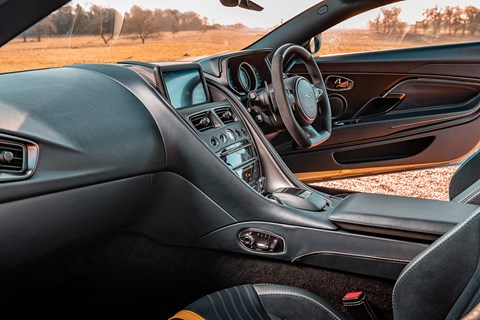
But for a car that is very much a 2+2 with its cramped rear quarters, the Aston feels big – wide to thread down a narrow street, and with a vast dashboard that rolls into a long prow of a bonnet like a Riva speedboat. The AMR is lightest here if still no lightweight at 1795kg, but excellent electric steering shrugs off that mass. The alcantara-wrapped rim spins from lock to lock with minimal effort, but also tingly feel, precision detail and a progressive weight that feeds back how hard you’re pushing. It encourages you to explore the Aston’s dynamics. The extra heft around top-dead centre that I remember from cars on the press launch in Germany isn’t as noticeable on this car, probably because it’s running Bridgestone Blizzak winters. Technically they’re in their operating window at 5ºC in the damp, but these tyres definitely add fuzz to the Aston’s normally keen responses.
Nonetheless, the Aston rides superbly. Other modes ramp up stiffness and response from the chassis and powertrain, but on these roads, in these conditions, there’s no need to venture beyond the GT setting. You feel the generous stroke of the damping still tightly controlling body movements while providing enough slack to rebound and compress without the jitters.
The Aston’s V12 is pushed further back in the nose than the Bentley’s, which manifests as a sense of mass more obviously centred between the axles. It ensures a real keenness to turn, and you roll the DB11 into a medium-paced corner knowing you have more options than the Bentley – no real risk of understeer on the road unless you’re daft, but a sense that it’ll pivot keenly but benignly around its middle with a quick lift of throttle. Some control weights don’t feel as precise as they could – there’s baggy travel in both paddleshifts and brake pedal, the latter suddenly waking up late, making accurate modulation tricky. But with winter tyres in relatively mild weather, it’s the lack of traction that really lets the AMR down.
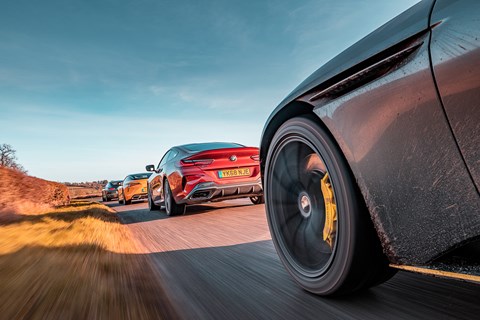
There’s sparkling response from the top of the long-travel throttle pedal, which the chassis soaks up well, but still a huge surplus of this car’s performance to unlock in the final third of travel. Up to third and fourth gear, it’s often a question of when not if the rear tyres will spin, and through corners the DB11 works its treadblocks hard and early. There’s a certain involvement to feeling out the grip, but mostly you know that if wasn’t for the ESP, this DB would be through the hedge and making like an actual David Brown at the first opportunity, where the Bentley and BMW simply power away. A V12 Aston would be traction-limited whatever, but regular tyres would’ve shown this car in a better light.
The LC500
The Lexus has a blindingly obvious alternative strategy for ensuring its rear tyres find traction – don’t throw so much performance at them in the first place. Its V8 is the only naturally aspirated unit on test, at the risk of appealing to motoring journalists who’ll carp on about its wonderful throttle response but alienating anyone who visits a Lexus showroom to discover it makes ‘only’ 458bhp and rewards with just 391lb ft after you’ve toiled hard to 4800rpm. In truth, it is a bit stolid below 4000rpm.
But the Lexus is a fabulous car. It looks compact and tautly drawn around its hard points, with a low-slung nose – part arrow-head, part futuristic egg-timer – that evokes the LFA supercar and emphasises that the 5.0-litre V8 is pushed far back in the chassis. Based on the same ‘Global Architecture – Luxury’ rear-wheel-drive architecture as the LS 7-series rival, it looks bespoke and special where the BMW appears a saloon turned into an extravagant coupe despite its similar upbringing.
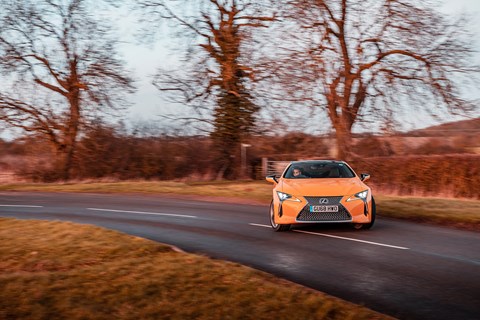
You sit low in sports seats that have the same lack of squish as the exterior design, grip a purposefully small steering wheel, and pull back on a short auto gearstick that extends from a high-set centre console. Alongside, your passenger has not one but two grab handles. Located where the dashboard cascades down into the left-hand door casing and the centre console, they grip them like a tailgunner’s controls. It all subtly implies that the Lexus is more focused sports car than loungey GT. The infotainment is via wilfully different touchpad, there are buttons you might find in a Prius, the feel is a little austere, but it’s also purposeful and of high quality.
On the move, the Lexus feels lighter and more compact by a margin than everything else, a subjective hunch that’s only partly backed up by the figures – the LC is a fraction longer than the Aston,4 and lighter only than the Bentley. I don’t know whether to be impressed it masks that so well or disappointed it doesn’t weigh less. At least a 90-percentile adult can squish in the rear seats for a short journey.
Our test car gets Sport+ specification, complete with variably geared steering, locking diff and rear-wheel steering. The latter two blend so subtly into the dynamics you might not notice at all, and complement a responsiveness that permeates this car: rigid body, firm-if-compliant suspension, steering that’s light but accurate, brake pedal drawn tight, the magnesium alloy paddleshifters similarly punchy. Just occasionally bigger bumps thwack crudely through the structure and you might notice some over-keen ABS intervention on rough sections, but these are exceptions rather than the norm.
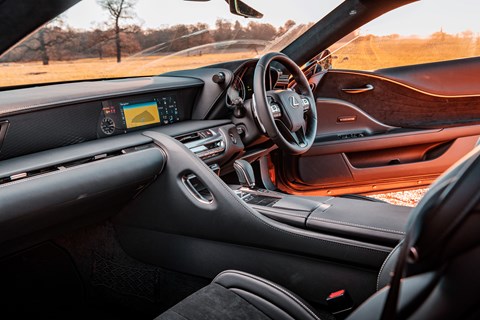
And then there’s that engine. What the V8 lacks in low-down torque it makes up for with the way it wakes up at 4000rpm and pulls hard to an only mildly disappointing 7200rpm and a 10-speed gearbox that helps keep it on the boil, never seems excessive and fires in super-fast downshifts accompanied by an angry bark of revs.
The performance figures might disappoint on paper, but they don’t on a wintry road – you can drive the Lexus hard in horrid weather, never fearing a spike of boost will spit you off the road, but always with the option to crank the sweetly balanced chassis out of shape and have the revs snorting and honking. I haven’t driven the new Supra, but is this the car it should have been? Picking an order on a test like this is a challenge, because there are such different characters and prices at play, each highly enjoyable for different reasons. With that in mind, the BMW seems a rather undeserving last. A Bentley on a budget, it’s refined over a long distance, strikingly styled, technologically advanced and both engaging and competent on a twisty road. It also recorded the best fuel figures on a test that should be far harder than typical usage, at 23mpg. It’s an extremely good car, and I’d enjoy owning one.
But I prefer the Lexus. I prefer its compact feel and the bravery of its idiosyncratic design, I admire its powertrain, and I adore the tight, intimately focused feel that floods through the driving controls. If I were spending my own money, I’d put it in the Lexus, partly because it’s cheapest, but also because it’s brilliant.
Final thoughts
It is not, however, the best car here. That comes down to a straight fight between the Aston and the Bentley. Normally, I’d lean towards the dynamic focus of the Aston, and previous experience tells us the AMR is a highly engaging driver’s car. But there’s no escaping that on this test it felt out of sorts on its winter tyres, neither as sharp as the car I last tested, nor capable of deploying anywhere near its full performance on wet roads.
It’s why the spoils go to the Bentley Continental GT. It lacks the Aston’s finesse and excitement as a pure driving machine, and that is a crucial shortfall if you spend your life on trackdays or driving tours. But the Bentley is some £16k cheaper, equally rapid and more sure-footed whatever the weather. It is also imperiously refined, boasts an exquisite interior that’s far beyond anything else tested, and its technology leaves the Aston lagging too. The Bentley’s broad spread of attributes probably hits the bullseye for most buyers of fast, luxurious GTs on a day the Aston feels a bit off-colour. Tough call, but the Conti wins.
Thanks to Stapleford Park, staplefordpark.co.uk
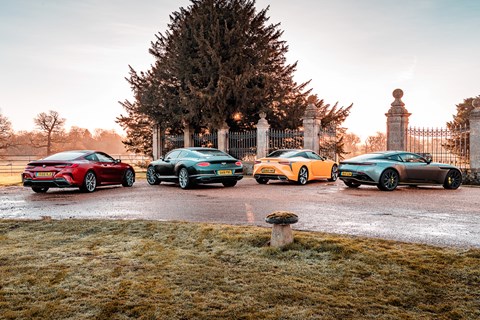
Best luxury GT: verdict
First place – Bentley Continental GT
Soothing refinement, wicked turn of speed, exceptional quality, but no trackday hero.
Second place – Aston Martin DB11 AMR
Beautiful design, dramatic V12, thrilling drive. Kneecapped by its winter tyres.
Third place – Lexus LC500
Drives as sharp as it looks, with a fabulous V8. A mini Aston.
Fourth place – BMW M850i
Fast, refined and good to drive, with excellent technology. A mini Conti.
Check out more of our Best lists here